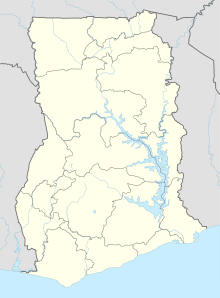Begho
Coordinates: 7 ° 51 ′ 0 ″ N , 2 ° 29 ′ 0 ″ W.
Begho (also Bighu or Bitu ) was an old trading town in what is now Ghana , near the present-day village of Hani (south of the Black Volta ) on the Nimpeni River .
The city had some importance as a caravan base from the 11th century until it was abandoned in the 18th century.
In 1471 the city was first visited by the Portuguese . In the 17th and 18th centuries Heerman Abramsz and the Arab scribe Khitab Chunja described it as an important trading center, who supplied Djenné with products from the Akan rainforest , such as gold and ivory. Even in the 17th century, the city was referred to as the center of the textile industry by the Dutch cartographer Hans Propheet .
Excavations have uncovered a large city complex that, with around 10,000 inhabitants, was one of the largest in West Africa . The urban area comprised an oval with a diameter of four to five kilometers. The city was divided into four city quarters, in which different ethnic groups lived, including probably Muslims . The house units, of which around 1500 could be observed, were made of adobe bricks, were rectangular and had flat roofs. In the finds, however, the districts hardly differed. There was a large market square in the middle of the city.
The excavations show a lively craft. Remains of copper , ivory, ceramics and textile processing were found. The food was based on agriculture, with remains of domestic animals (cattle, sheep, goats and pigs) found, and wild animals such as antelopes were also hunted.
There was plenty of evidence of extensive trade, including German earthenware , Delftware , Chinese porcelain , and Dutch and Venetian glass beads.
The discovery of ivory trumpets, which serve as a symbol of rule for the current chief of Hani, indicates that a king ruled and that Begho was a city-state.
literature
- LB Crossland: Pottery From the Begho - B2 Site, Ghana . 1989, ISBN 0919813844
- James Anquandah: Urbanization and state formation in Ghana during the Iron Age . In: T. Shaw, P. Sinclair, B. Andah, A. Okpoko (Eds.): The Archeology of Africa . London / New York 1993, pp. 642-651, ISBN 041511585X
Individual evidence
- ^ Joseph Kaminski: Asante Ivory Trumpets in Time, Place, and Context: An Analysis of a Field Study. In: Historic Brass Society, Vol. 15, 2003, pp. 259-289
